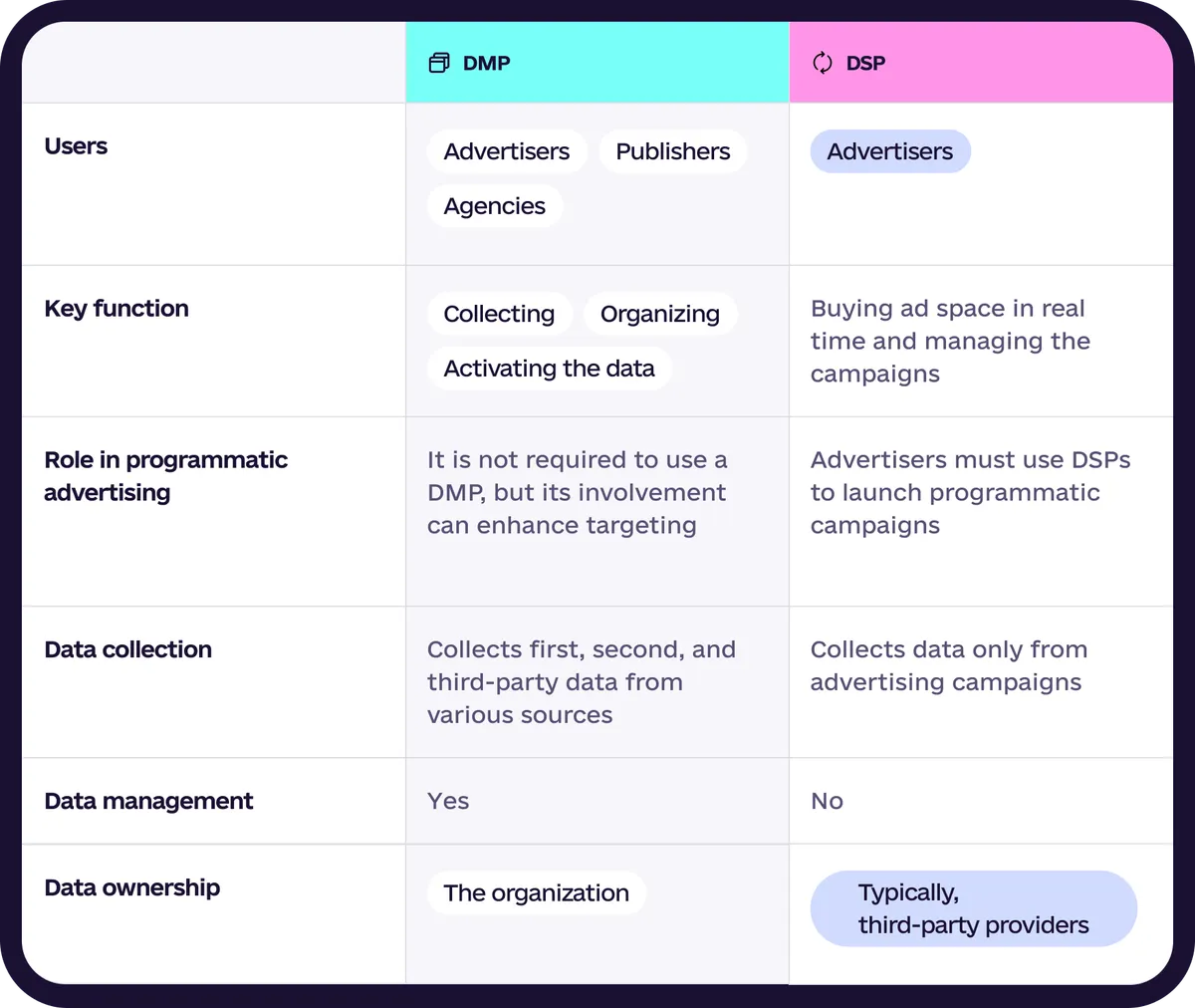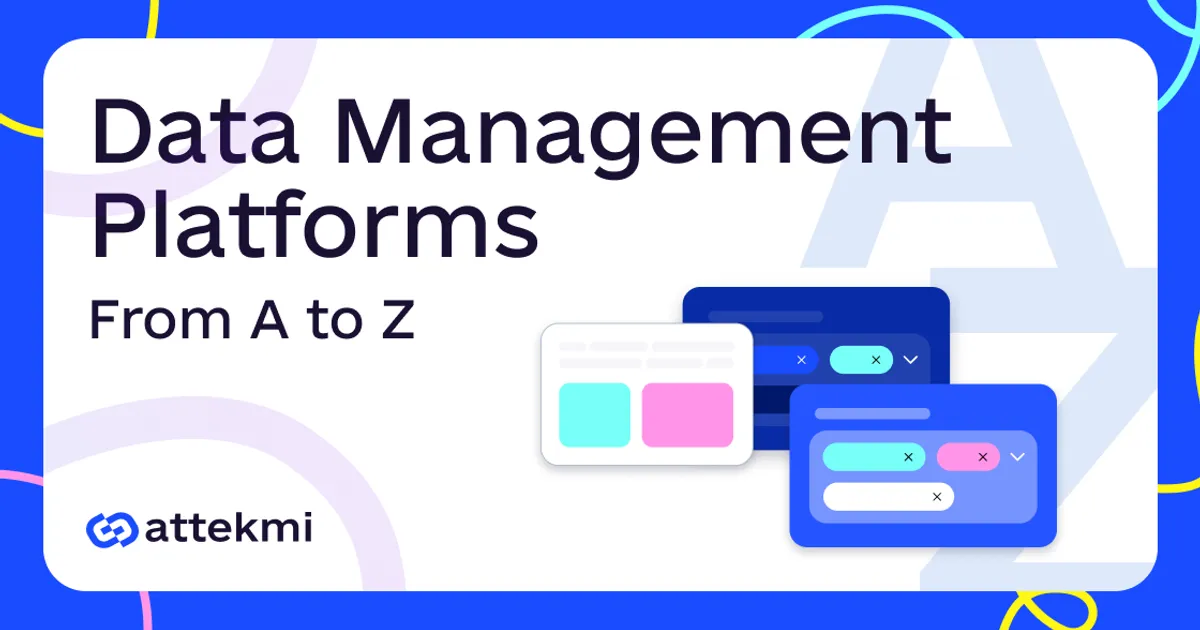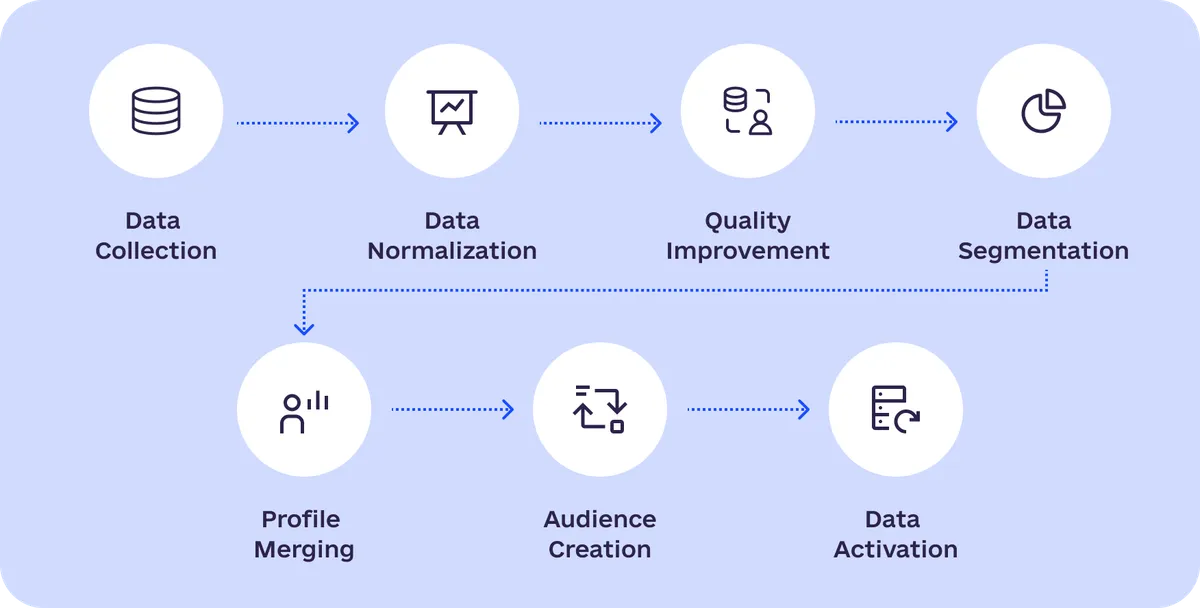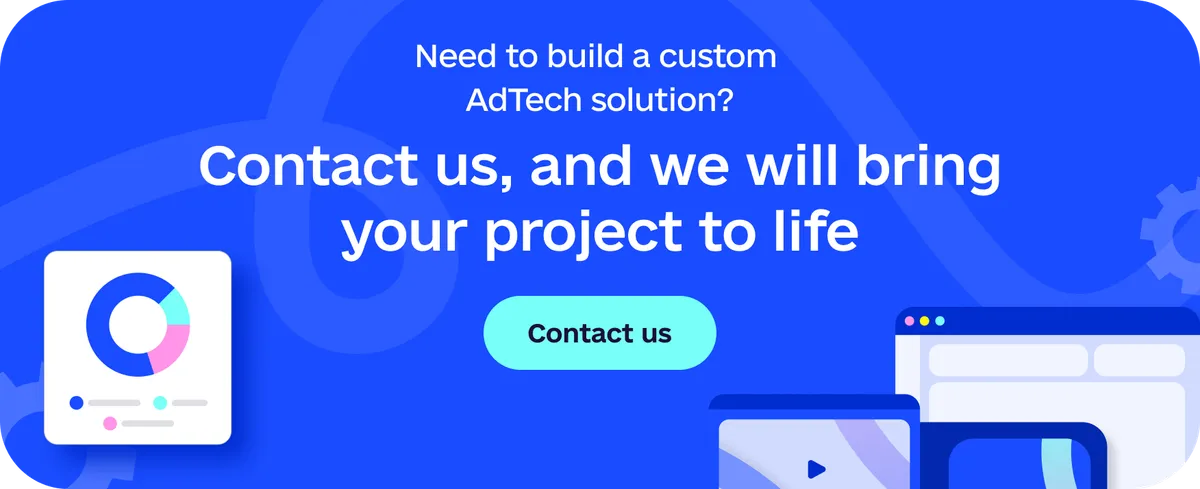The AdTech industry offers multiple solutions for effective marketing, and data management platforms (DMPs) are on this list.
But what exactly is a DMP platform? How does it work? Why is it important? Understanding all the nuances can be challenging, but this guide is here to clarify everything. Keep reading to understand how you can benefit from using a DMP in digital marketing.
What is a data management platform (DMP)?
A data management platform (or DMP for short) is a solution that collects, stores, and organizes data gathered from a variety of sources, such as websites, apps, marketing campaigns, etc. Businesses leverage DMPs to get a better understanding of their audiences, ensure great campaign personalization, improve targeting, and optimize the strategy and advertising spend.
What types of data does a DMP collect?
There are three types of data that a DMP (data management platform) software can collect: first-party data, second-party data, and, obviously, third-party data.
First-party data
First-party data is gathered straight from users and customers. It is considered the most valuable information since the data is collected via direct interactions and is highly relevant. The sources of such data are usually customer relationship management systems (CRMs), web and mobile analytics tools, and transactional systems. As for specific data examples, these are website visits, purchase history, social media engagement, etc. A well-executed first-party data strategy allows businesses to segment their audience more effectively, optimize user experience, and create personalized marketing campaigns that drive higher conversion rates.
Second-party data
Basically, second-party data is the same as first-party data. However, you do not collect it on your own – instead, you get it from a different company. Such partnerships and data-sharing agreements are usually established between non-competing businesses that have the same target audiences. For instance, a website selling sports clothing can become a partner of a gym network’s website.
Third-party data
Third-party data is usually provided by data collection companies and DMP vendors. It is less accurate than the first-party data, however, it is still in use, often in combination with the information that the brand gathered on its own. For instance, a business may add a DMP’s pixel to its website. Since the data will be collected by a DMP, it is considered to be third-party. Alternatively, such data may be simply sold to marketers.
How does a DMP work?
Now let’s find out how a DMP works. The steps are as follows:
Data collection. This is done by integrating the platform with other solutions (DSPs, SSPs, ad exchanges, etc.) and by adding a tag to a website.
Data normalization. This stage includes removing unnecessary data, collecting IDs from cookies, and so on. The data is organized into a common format.
Quality improvement. Then, the quality of the data is improved by adding extra points like location, device type, operating system, and others.
Data segmentation. Every piece of data is thoroughly analyzed and categorized to create user profiles.
Profile merging. All profiles that contain a common identifier (for instance, a cookie ID) are converted into a single profile.
Audience creation. This implies creating groups of profiles with common user identifiers. For instance, if you create an audience and name it “iOS users in the UK”, it will contain profiles with the relevant attributes.
Data activation. Finally, the data is used for targeting, content personalization, and other tasks.
Why are data management platforms important?
The main benefit of a DMP is that it centralizes data from multiple sources and provides a unified view of customer behavior. This way, it becomes much easier for you to manage and analyze the data and then use it for more effective targeting, campaign optimization, and other tasks. To sum up the benefits of data management platforms, they are as follows:
Audience insights
Management of multiple campaigns across different devices
All campaign and customer data are connected
Data assets are maximized
Effective segmentation and targeting
Marketing campaigns become easy to scale and optimize
Content personalization
Revenue optimization
What’s the difference between a DMP and a DSP?
So, a DMP vs DSP. It is crucial to remember that these are not the same solutions. A data management platform collects and organizes the data. It focuses on the target audience. In turn, a DSP is a demand-side platform, a programmatic solution that is used by advertisers to purchase digital ad inventory in real time. Let’s review the key differences in detail.

This way, DMP advertising ensures more precise targeting. However, it is not essential to use such a platform to launch your campaigns.
What you can do with DMPs
Now that the benefits of DMP marketing are clarified, let’s discover for which specific tasks you can leverage such a platform.
Audience segmentation
With a DMP, it becomes easy for you to segment your audience according to their behavior, interests, needs, and other characteristics. Moreover, after segmentation, the platform can even find similar audiences for you or expand the current ones during campaign planning. This way, it can help you not only enhance targeting but also broaden your reach.
Ad personalization
Instead of creating random ads, you can launch highly personalized campaigns, and this is not only about audience demographics. For instance, the platform can identify the products or services that specific audience segments may be interested in. Therefore, you can promote exactly these items.
Insights collection
The analytics capabilities of DMPs make it much easier to collect audience insights. Apart from analyzing the already existing information, you can detect patterns in new data and even conduct some general market research to identify key characteristics.
Cross-device targeting
Data management platform advertising solutions integrate data across various devices. This enables you to ensure a consistent and personalized experience for your audience in different environments.
Staying compliant
Last but not least, using a data management platform can help you stay compliant with data privacy regulations and standards. Privacy remains an important topic nowadays, and collecting and using data in the wrong way can lead to fines and issues with brand reputation. In turn, a DMP can assist you with preventing such unpleasant consequences from happening and staying within the law. You only need to choose a solution that is compliant with regulations.
Future trends in data management platforms
If you search for DMP examples on Google, you will see that there are plenty of solutions available in the market. However, since the industry evolves continuously, we can expect new trends to start impacting data management platform solutions. Take a look at them.
The growing impact of data privacy regulations
Users are getting more and more concerned about how their personal data is used. Regulations and standards like GDPR and CCPA reflect these concerns – they are getting stricter. Requiring specific consent mechanisms and transparency regarding how data is collected, used, and shared, these laws impact the way DMPs operate, and this impact is expected to increase in the near future.
At the same time, the platforms are likely to adopt more robust data security measures, such as encryption technologies and blockchain-based solutions. Platforms failing to do this, as well as to keep pace with the evolving regulations, are not going to survive in the market.
However, those DMPs that manage to overcome the above-mentioned challenges will be in demand. Businesses also strive to be compliant with GDPR and other laws, so they require solutions that enable them to do this.
First-party data becomes more important
Third-party cookies are steadily fading away, while data privacy standards, as we already mentioned, are getting stricter. Considering these two facts, DMPs are switching to first-party data and are expected to offer identity resolution capabilities to ensure effective audience targeting and segmentation. For such solutions, this is a crucial step in order to remain competitive.
For advertisers, this transition is beneficial, as they will be able to use DMPs that promote transparency and respect user privacy. Besides, this will help marketers themselves be compliant with data privacy laws.
Integrations with other solutions
As you know, DMPs can integrate with numerous AdTech solutions, like demand-side platforms, supply-side platforms, and others. However, integration with customer data platform (CDP) is becoming a trend. Such a merger ensures a more comprehensive view of the customer journey, which means that marketers can create more detailed audience profiles and improve cross-channel advertising strategies.
Additionally, we can expect an increasing number of integrations with marketing automation platforms (MAPs) and customer relationship management (CRM) platforms. Thanks to this, advertisers get a more unified view of their marketing efforts.
Increased adoption of AI and ML
Artificial intelligence and machine learning keep evolving, and this implies new opportunities in the AdTech (and not only) industries. DMPs are projected to become more integrated with AI and ML technologies, which will ensure more accurate data analysis and, as a result, more relevant audience segmentation. The process of analysis itself is also likely to become faster.
Additionally, DMPs may get equipped with user behavior predictive capabilities and the ability to learn from previous interactions. This way, a DMP campaign can become more targeted and efficient in general.
The growth of industry-specific DMPs
Since the demand for first-party data is increasing, we can also expect the rise of DMPs focused on specific industries: finance, healthcare, and others. This can help ensure greater relevance of the data and, as a result, a more effective marketing effort.
Adoption by small and medium-sized brands
Data management platforms have always been popular among large companies. However, this tendency is changing as more and more small and medium-sized businesses are starting to adopt DMPs. The adoption rate is forecasted to increase due to the opportunities offered by such solutions.
Consider Attekmi your trusted partner
At Attekmi, we are ready to help you with any AdTech matter. First of all, we offer a wide selection of ad exchange solutions: starting from a basic option and ending with a fully customizable platform:
AdEx Basic: an entry-level solution with basic functionalities.
AdEx Plus: a platform offering additional capabilities.
AdEx Enterprise: a solution with advanced features and ultimately scalable nature.
White Label Ad Exchange: a platform that gets fully tailored to your needs, including UI personalization and custom on-request feature development.
Secondly, we provide the following services:
Custom AdTech development: we can bring your AdTech project to life.
AdTech and Ad Ops training (both team and individual): we are ready to share our knowledge and experience with you.
Ad Ops outstaffing: we can train an expert specifically for your business so that you can focus on your core tasks.
We are here to cover all your AdTech needs. Thus, with our ad exchange platform, BidderMob managed to achieve 319% ROI and upscaled to 100k QPS. You can reach the same (and even greater!) heights.
Are you ready to bring your business to the next level? Contact us, and we will help you.
 By Anastasiia Lushyna
By Anastasiia Lushyna

